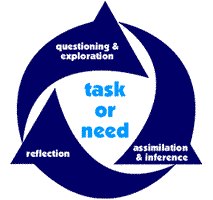Collaboration for Inquiry
 How do I collaborate with a teacher to change a traditional assignment into an inquiry-based experience?
How do I collaborate with a teacher to change a traditional assignment into an inquiry-based experience?
Rather than building lessons and assignments, think of ways to establish a learning environment conducive to inquiry. Keep in mind that inquiry isn't a linear series of steps, instead it's an ongoing cycle of questioning and exploring, assimilating and inferring, and reflecting then continuing with new inquiries. Like a spiral, it moves deeper and deeper with each inquiry. Danny Callison developed the visual on the right to visualize this cycle.
To learn more, read The Blue Book on Information Age Inquiry, Instruction, & Literacy by Daniel Callison and Leslie Preddy.
What is Information Inquiry?
Standards-based, real-world, problem solving, and information searching that carries on into adult, lifelong literacies necessary for a democratic society. According to Callison, inquiry is "an application of the ancient Socratic Method of teaching through self-posed and mentor-posed questions in order to gain meaning in today's overwhelming information age.
We must teach students to (Ian Jukes and Dr. Patricia Wolfe):
- Ask the right questions
- Access (the information)
- Analyze (the information)
- Apply (the information)
- Assess/Evaluate in their own words
Inquiry is the process of...
- Formulating appropriate research questions
- Locating and organizing search data
- Analyzing and evaluating the data found
- Connecting new knowledge to existing knowledge
- Communicating the results in a coherent fashion
- Self-reflection throughout the process
Successful Collaboration Strategies:
- Listen
- Observe
- Learn
- Be Flexible
- Accommodate Teaching Styles
- Plan Formally and Informally
- Take Notes
- Follow Up Communication
Benefits of Collaboration:
- Group support and advice
- Shared responsibility
- Shared workload
- Problem-solve with colleagues
- Learn, co-plan, co-teach from different perspectives
- Model for students how to function successfully as a group/team
- Co-teaching synergy that energizes the class
- Rewarding and long-lasting social & professional relationships with fellow educators
Things to Remember:
- Expect initial growing pains.
- Be a team when you teach - let kids see you having fun teaching together
- Support each other, especially in front of the students
- Different teaching styles can complement each other & show the kids that there is more than one approach to topic, problem, question, or process
References
Brazee, Ed. *Collaborating on Curriculum.* Middle Ground August 2000: 33-37.
Kuhlthau, Carol C. *Implementing a Process Approach to Information Skills: A Study Identifying Indicators of Success in Library Media Programs.* School Library Media Researcher Fall 1993. Online. Internet. 6 June 2001.
Stripling, Barbara. Learning and Libraries in an Information Age: Principles and Practice. Libraries Unlimited (1999), pp. 144-159.
Wolcott, Linda Lachance. *Understanding How Teachers Plan* Strategies for Successful Instructional Partnerships.* School Library Media Researcher Spring 1994.
Bohlmann, Natalie L. *Cooperative Teaching: A Model for Teacher Collaboration.* Teaching & Change Vol. 5 Issue 3/4, Spring/Summer 98, p 199, 26p. Available from Ebsco Host Professional Development Collection [database on-line].
Gable, Robert A. and M. Lee Manning. *Interdisciplinary Teaming: Solution to Instructing Heterogeneous Groups of Students.* Clearing House Vol. 72 Issue 3, Jan/Feb 99, p 182, 4p. Available from Ebsco Host Academic Search Elite [database on-line].
